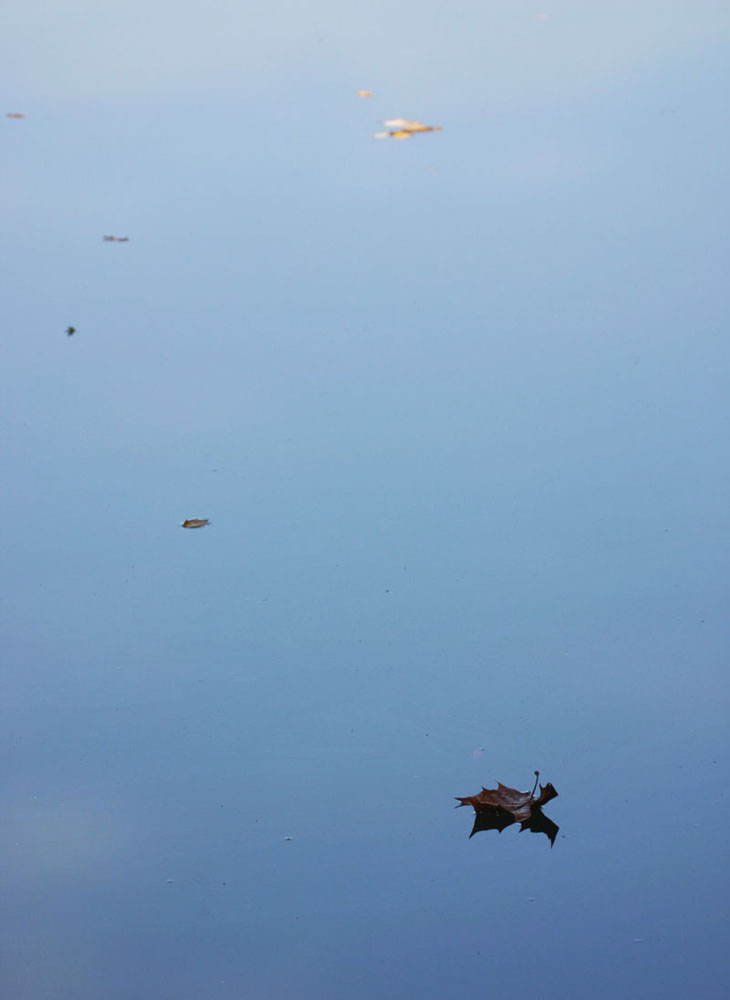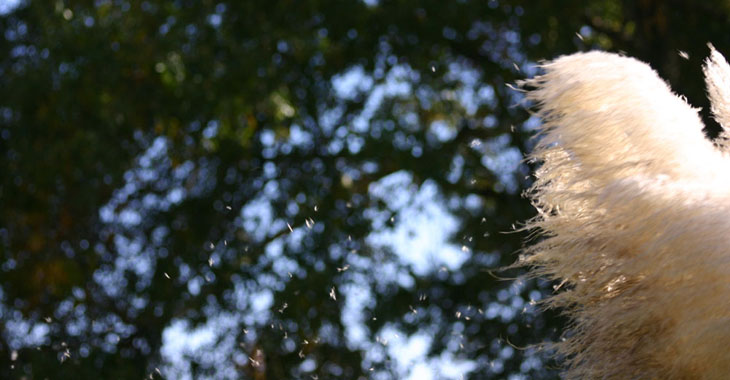
North Carolina winters are usually not too dire, and we can count on some good outdoor weather pretty much throughout, but this doesn’t mean that good photo subjects will be as readily available, so I’m resigned (albeit reluctantly) to the arrival of the slow season. This little gallery is my minor act of defiance.
Above, a photo that’s harder to capture than you might imagine. While the seeds of the decorative pampas grass are easy to spot when they propagate in a gust of wind, this is largely because they’re moving – a still photo lacks this advantage, so the puffs must be caught against either a darker or a smooth background, and numerous enough to communicate the idea. A gentle breeze isn’t sufficient. Waiting on the strong gusts is one of the typical frustrations of nature photographers; you spot the event without the camera ready, then wait patiently (or not) for it to repeat itself, whereupon the wind becomes incredibly shy. Since I’d switched to this subject because my macro attempts nearby were being thwarted by the wind whipping the plants around (necessitating a change of lenses to boot,) this was a great test of patience, to say the least.
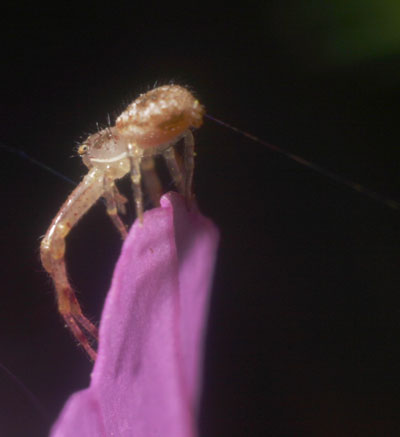 The breezy conditions can sometimes help with macro subjects, but not often. One of those rare occasions is seen at left, where a tiny crab spider was throwing out strands of web to travel between plants (and yes, this is an aster bloom like you’ve seen here so often before.) Spinnerets high in the air, they extrude a very fine web and let the wind take it, where it hopefully contacts another plant nearby and sticks; the spider then tacks down the near end and scampers across this tightrope. I’m always impressed with something that can adhere strong enough from casual contact to bear the weight of the spider – my mind tells me this really shouldn’t be a trustworthy anchor. Some spiders use this to make their orb webs, stretching between trees, plants, or your porch columns, but crab spiders do not make capture webs, preferring instead to lie in wait on an attractive subject, often camouflaged, and pounce upon insects that come to the flower. Getting any kind of spiderweb in the image is harder than it seems, because seeing the web requires just the right light angle and a dark background, and this is multiplied for casting behavior by the action being so brief. Don’t get the impression that I’m trumpeting my skills, because I attribute this to luck and perseverance – I have dozens of shots, within the past several years, of spiders just mooning…
The breezy conditions can sometimes help with macro subjects, but not often. One of those rare occasions is seen at left, where a tiny crab spider was throwing out strands of web to travel between plants (and yes, this is an aster bloom like you’ve seen here so often before.) Spinnerets high in the air, they extrude a very fine web and let the wind take it, where it hopefully contacts another plant nearby and sticks; the spider then tacks down the near end and scampers across this tightrope. I’m always impressed with something that can adhere strong enough from casual contact to bear the weight of the spider – my mind tells me this really shouldn’t be a trustworthy anchor. Some spiders use this to make their orb webs, stretching between trees, plants, or your porch columns, but crab spiders do not make capture webs, preferring instead to lie in wait on an attractive subject, often camouflaged, and pounce upon insects that come to the flower. Getting any kind of spiderweb in the image is harder than it seems, because seeing the web requires just the right light angle and a dark background, and this is multiplied for casting behavior by the action being so brief. Don’t get the impression that I’m trumpeting my skills, because I attribute this to luck and perseverance – I have dozens of shots, within the past several years, of spiders just mooning…
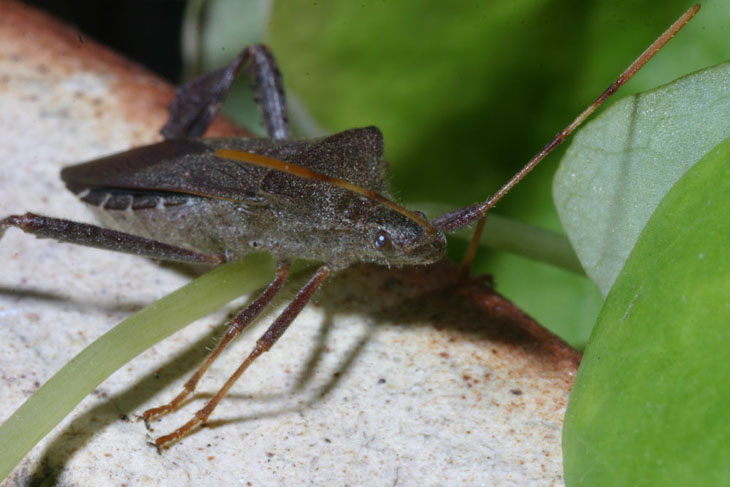
The shamrock plants of The Girlfriend’s Younger Sprog have proven to be more entertaining than expected. Even as they go into dormancy for the winter, they’re attracting bees and the occasional random insect, like this leaf-footed bug, Leptoglossus oppositus, who was sluggish enough to permit lots of close shots. You can get some idea of the difference between the Mamiya 80mm macro lens and the Mamiya 45mm reversed, both spoken about here, by the shots above and below. The one above is the 80mm, though full-frame; below we see a detail shot from the reversed 45mm, but this is a crop of only about 1/4 of the frame. Note the additional simple eye above the compound one.
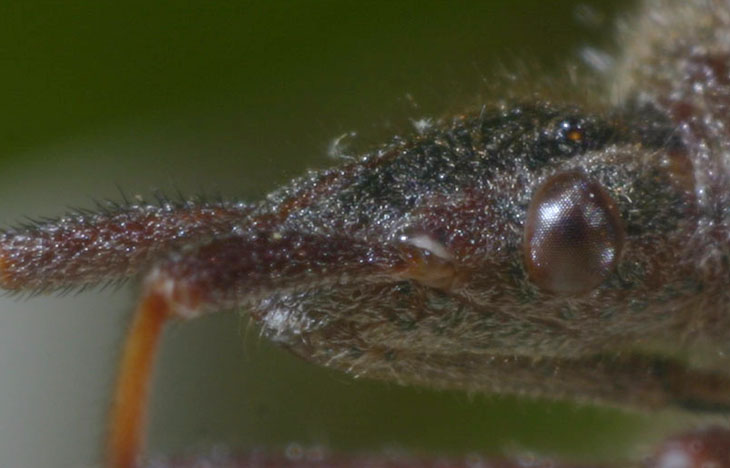
On the same trip that I featured in this post, I got a couple of other images. Below is a magnolia green jumping spider (Lyssomanes viridis) whom I spotted on the underside of a leaf when I’d sprawled on the ground pursuing another spider. The sunlight coming through the leaf was also coming through the tiny spider, but capturing this demonstrates the tradeoffs of photography.
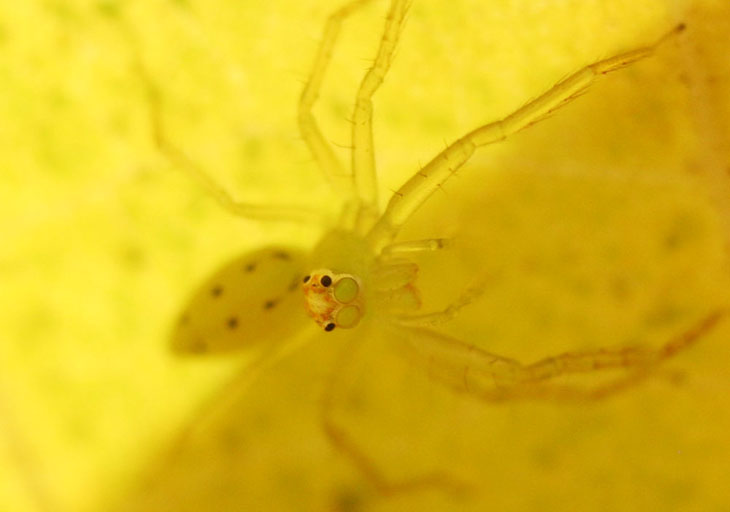
Macro work benefits from a high depth of field, which means a small aperture. Which means greatly limited light, thus either a) going for a longer exposure, b) increasing the ISO, or c) getting extra light in there, which is my typical method – virtually all of the macro images you’ve seen here are accomplished with strobes. That wouldn’t have worked with the sunlight through the leaf, though, and the slight breeze was enough to prevent a long exposure – not to mention the reluctance of the spider to hold still dependably, and the fact that I had skipped the tripod on this trip. The Canon 300D (Digital Rebel) drops significantly in quality with higher ISOs, so I went as high as I dared with ISO 400, and skipped the depth of field, shooting at only f5.6. As can be seen, this meant that most portions of the spider (which could have fit comfortably on your thumbnail) dropped out of focus, but I got the lambent primary eyes, which is the most important point. Those two big eyes facing front, in fact, are the telltales of a jumping spider, which helped a lot in identifying it because that’s not a typical jumper’s leg arrangement.
And finally, another frame from that trip (I’m not sure I should call this a ‘trip’ when it’s only 3 Km away.) I had originally included this image with the previously linked post, then removed it because I felt it wasn’t as strong as the others. A friend, however, indicated that he liked this one best, and it does illustrate how I feel about the seasons pretty well, so it makes a triumphant return.
